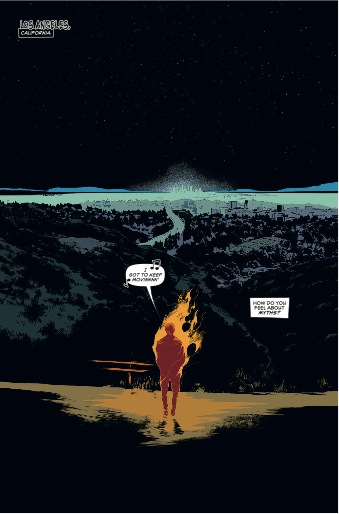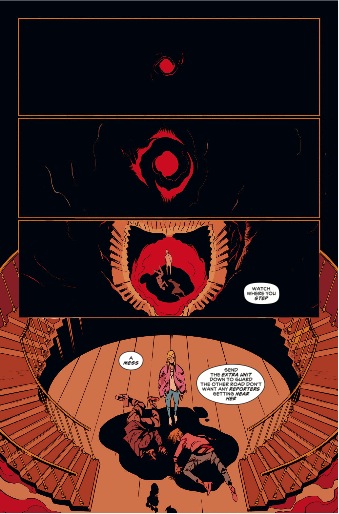
Written by Ales Kot
Illustrated by Matt Taylor
Coloured by Lee Loughridge
Lettered by Clayton Cowles
Published by Image Comics
One of the first lines spoken in Wolf is in the form of a question: “How do you feel about myths?” The question floats around and isn’t brought up again until about the mid way point of this first issue. The subject of myths are discussed through a conversation, placing them as something that should, and perhaps already has to a certain extent, face the need to evolve over time. Stories are reworked, remade, and touched up in favour of the changes made over time, as certain aspects of these myths may appear outdated, stuck in a particular loop of time; a Mobius strip one could say. Wolf approaches this ideology of challenging traditional myths by respecting their origins but plays with the potential to invent and distort the understandings of previous storied notions.
Antoine Wolfe is first seen completely engulfed in flames, looking over the landscape of Los Angeles, California. It’s an image that is simultaneously beautiful and haunting, provoking thoughts of Pink Floyd’s Wish You Were Here. Wolfe presents his past in the form of dog tags that hang around his neck, rising up again through dreams and voices he hears in his head. His previous night, one that ended up in flames, literally, is the topic of conversation as Wolfe tries to explain to a police officer how exactly he got to be in that sort of precarious position. As Wolfe returns home, it is clear that the world this Los Angeles exists in is one where the supernatural run rampant.
Characters Wolfe comes across open up the various elements that could aid and/or interfere with his investigative occupation. These include a Cthulu-based character named Freddie Chtonic, a mysterious man named Sterling Gibson that employs Wolfe for a job, and a young girl whom is apprehended at the scene of a violent crime. Ales Kot has taken advantage of the extended page count by introducing these intriguing characters and relying less on exposition in favour of tone.
Matt Taylor’s art style is a mix between minimalism through the simple presentations of the characters and photo-realistic with the way the backgrounds blend with their surroundings. The focus lies on the characters as they occupy the space of most of the frames, tensely gazing at one another through hypnotizing stares. The combination of stark body language and intense shadowing gives off this neo-noir vibe, occasionally giving light to what hides in the darkness. Taylor also utilizes silent moments well, taking Kot’s script and implementing it through a cinematic flow of intense close ups, wide frames in a deep focus, and hazily adjusting images to show their true form through a play on focus or fading in if you will.
 The colouring of Wolf is in the safe hands of Lee Loughridge, evident from the stunning first couple pages. The dark reds bleed away from the orange and yellow waves of flames that envelope Wolfe, appearing again later to capture another moment of violence. Loughridge’s colours evoke less a neon appearance and more of a David Lynch dream-like haze through layered tones of similar colours.
The colouring of Wolf is in the safe hands of Lee Loughridge, evident from the stunning first couple pages. The dark reds bleed away from the orange and yellow waves of flames that envelope Wolfe, appearing again later to capture another moment of violence. Loughridge’s colours evoke less a neon appearance and more of a David Lynch dream-like haze through layered tones of similar colours.
Clayton Cowles’s does a great job at handling Ales Kot’s dense script, maneuvering word balloons within the same frame, respecting the space that the characters of Wolf exist in. There is a great understanding of when and where to use sound effects as well, allowing for Taylor and Loughridge’s art to speak for itself.
Ales Kot enters further into the realm of blending the real world with the supernatural, presenting Wolf as the sort of story that will bring in fans of John Constantine or the brilliant Fatale. The various, enigmatic characters are developed enough through the larger premier issue warranting a strong curiosity as to the direction that this creative team is going in.

